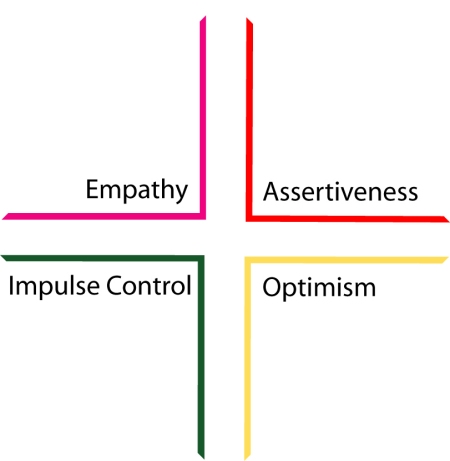Article by Marcia Hughes
“The single biggest problem in communication is the illusion that it has taken place” – George Bernard Shaw
Successful leaders exhibit skills that may look natural and easy are truly the result of paying close attention and being responsive to the whole environment. To do so, they learn to be emotionally literate and employ a complex set of skills in ways that may seem innate though in fact are the result of a willingness to work, learn and improve. Leaders often find that their cognitive intelligence is the threshold for their success, and they do need solid IQ smarts and a good education to get in the door and to keep up with technical and professional developments. To move beyond that threshold they need to be adept at relationships, influencing and leading staff and teams effectively. The path for exhibiting this excellence is based in emotional intelligence:
“a set of emotional and social skills that influence the way we perceive and express ourselves, develop and maintain social relationships, cope with challenges, and use emotional information in an effective and meaningful way.”
The most powerful and sustainable way to build those relationships requires using the four emotional intelligence skills demonstrated in this graph below.

The artful use of these four skills creates a resilient environment and is well supported by using the EQ-i 2.0 with the leaders. We also find considerable value by measuring team skills as well with the Team Emotional and Social Intelligence Survey®. Together these two assessments present a powerful picture that supports developing leadership capabilities.
In a real-life case, Carl (real name is concealed) became the new CEO at a large hospital and faced big challenges such as leading the medical staff, the administrative staff and various boards to work together. Carl is one smart IQ person and he needs all those smarts! He was leading new change initiatives, changing reporting relationships and strategizing on how to meet financial challenges that have built up over several years. He also needs to build loyalty, solid relationships and a desire among a staff of many different backgrounds from neurosurgeons to administrative staff to work together and build a new future together. Every day, he exhibits skills in all four dimensions of this success diagram.
Empathy
People know he understands how hard they are working and that change can be painful, they feel his compassion and genuine interest in them.
Assertiveness
He is assertive, there is no doubt that the changes are to be made. His staff knows that they are expected to perform to the new standards and will be held accountable if they don’t. When actions are unacceptable he makes it clear; however, this isn’t necessary often because he communicates what is needed up front and the requirement of accountability is clear.
Impulse Control
His expert use of impulse control is reflected by his measured responses when something goes wrong and his thoughtful engagement on complex matters as he helps all involved recognize that big problems take time to resolve successfully.
Optimism
He leaves no doubt about his belief that they will be resolved, thus exuding consistent optimism. His staff gains hopefulness and inspiration, they know he cares about them and will hold them accountable. It is a healthy proactive structure that is gradually turning a big ship around since he started six months ago.
When leaders seek to guide and influence others we know they need to communicate – but how? The choice that gets the desired results taps into the four corners of empathic assertiveness. These are four of the fifteen skills measured by the EQ-i and the good news is they can be developed and improved in all motivated leaders. It is best for the leader and his/her coach to review the results from taking the EQ-i and create a game plan that calls for these skills to be used in synch. If a leader one day pats an employee on the back and praises him or her. Then next day the leader impulsively yells about a mistake, it can be difficult for the employee to trust the relationship. The leader needs to learn to bring those skills together in a cohesive message. Let’s assume a leader, I’ll call Mary makes one of the following two communications:
“Nancy, I’m so disappointed with the errors in your report, we worked with you so hard last time and here you are making the same kind of mistakes again. Now, do it right and have the memo on my desk by 10 a.m. tomorrow!”
OR
“Nancy, I appreciate your desire to get this project completed on time, but quality has to matter just as much as timeliness. Please take time to correct the errors, get help from others on the team as you need, and give me your proposed final memo by tomorrow at 10 a.m. I know you can get this done well just like you did with last month’s project.”
If Mary was just assertive and didn’t manage her impulses her irritation at the poor quality could cause Nancy to be less resourceful, Nancy is likely to move away emotionally from the project and from Mary rather than moving toward the project and rolling up her sleeves to accomplish even more. The second message incorporates all four skills and is more likely to lead to success.
How to be successful with the Four Corners model?
Empathy is demonstrated by understanding the emotions people are communicating and responding to them. This is key to building trust, engagement and passion. Demonstrating empathy can take just a moment, if you see that someone is surprised, worried or perplexed, acknowledge the emotion, connect it with a reason you believe is related and give the person time to correct you if needed and to respond more. “You feel perplexed because these two goals seem contradictory.” Also, be sure to give the person time to speak.
Assertiveness is demonstrated by the ability to speak up, to make your points, to say no when called for. Leaders can develop their skills with assertiveness by intentionally saying what is important to them and by practicing saying no by being clear about their priorities. A leader’s staff and teams want to hear from him/her, but the way that the assertiveness is communicated will make all the difference in how it is accepted.
Impulse control includes the ability to manage impulses, be patient and to control the desire to be angry. Howard Book writes in his chapter “When Enhanced EI is Associated with Leadership Derailment” (The Handbook for Developing Emotional and Social Intelligence, Hughes, Thompson and Terrell, 2009) that impulse control is a primary skill upon which all other cognitive and emotional skills depend. Leaders with poor impulse control make haphazard and poorly thought out decisions. Rich Handley in his chapter “Advanced EQi Interpretation Techniques” in the edited volume presented his research on the relationship between the fifteen EQ-i skills in which he found the EQ-i skill that supports the most successful use of an identified EQ skill, e.g., for emotional self awareness that supportive skill is impulse control. It turns out that impulse control is the most influential of all the skills. If someone overuses impulse control they may be risk adverse and just play things too safely. Someone low in impulse control at best will irritate others and at worst will burn many bridges. Leaders can develop their impulse control by finding ways to stop and think before they speak. We often suggest a leader use stair therapy – if they are feeling impulsive or even explosive we urge them to go climb a set or more of stairs before they say anything. There is no doubt that getting oxygen to their brain and incorporating physical movement will be helpful.
Optimism is the demonstration of hopefulness. When leaders help their teams believe they will find an answer even when the going gets tough, they are building optimism. Plentiful research is demonstrating the power of positive mood. Leaders can build optimism through the way they talk about challenges. Speak of challenges in limited ways, frame the concern so it’s not so global or big that it can’t be handled and say, “we just haven’t found the answer yet. The word “yet” creates a presupposition that the answer will be found!
The art of developing successful leadership is created by bringing the right skills together so leaders can experience a resilience that is sustainable even when tested.
About Marcia Hughes
Marcia Hughes is President and CEO of Collaborative Growth, L.L.C., and serves as a strategic communications partner for organizations. Marcia works with organizations to support strategic decision making and effective communications. She is an international expert in emotional intelligence for leadership and team development. Marcia is co-author with James Terrell of the Team Emotional and Social Intelligence® Survey (TESI®), an on-line assessment, and several books including The Emotionally Intelligent Team, The Handbook for Developing Emotional Intelligence, Emotional Intelligence in Action, and Life’s 2% Solution. She previously operated her law practice and worked on complex multi-disciplinary public policy issues at the national, state and local levels. Learn more at www.cgrowth.com and www.EITeams.com.





 Posted by eiinsider
Posted by eiinsider 



